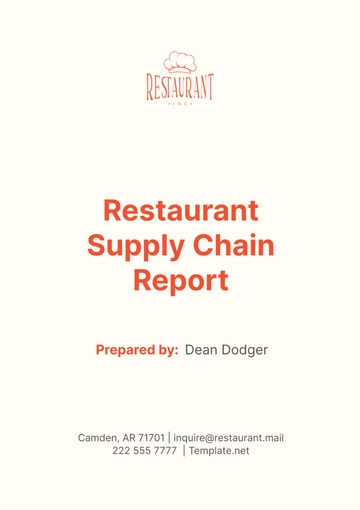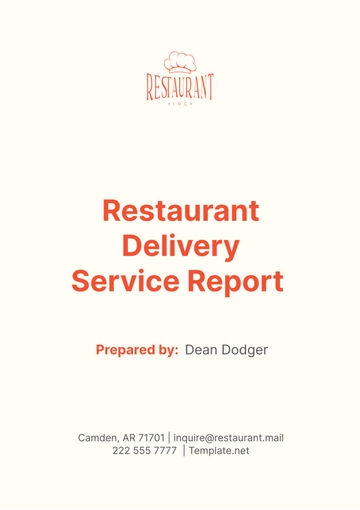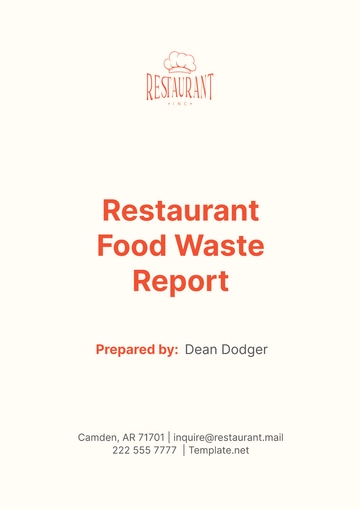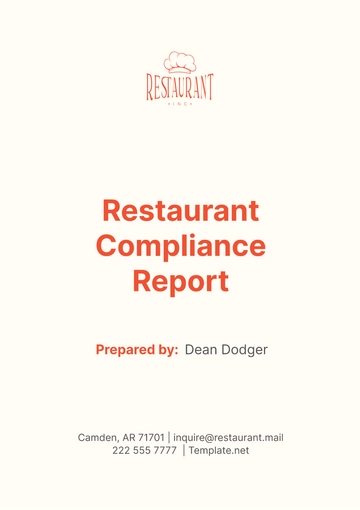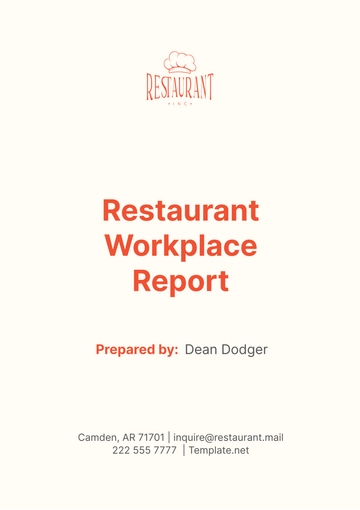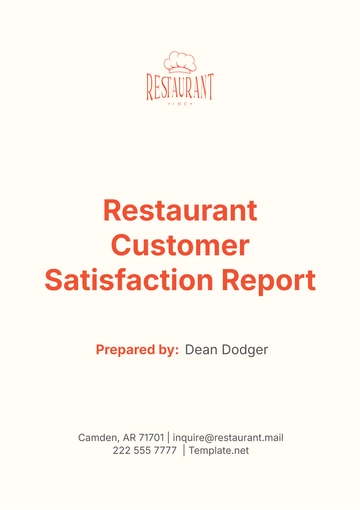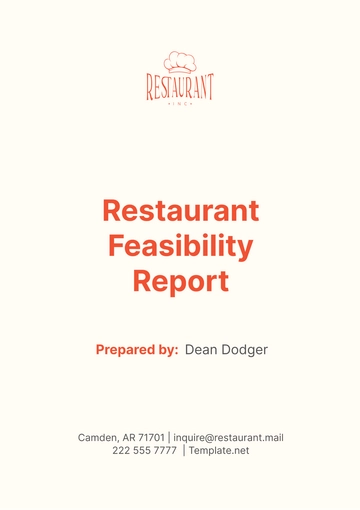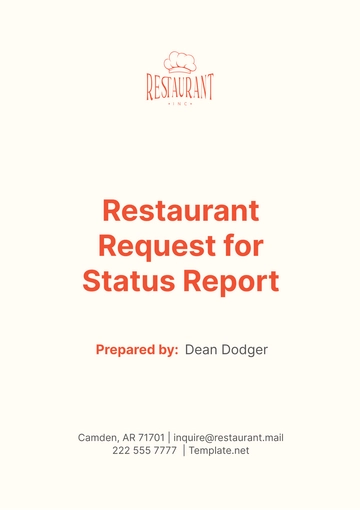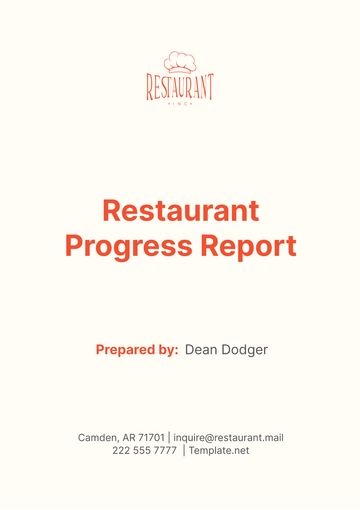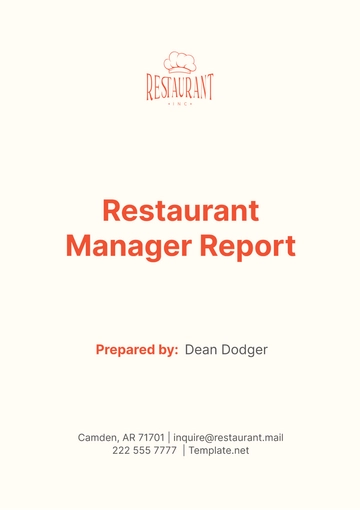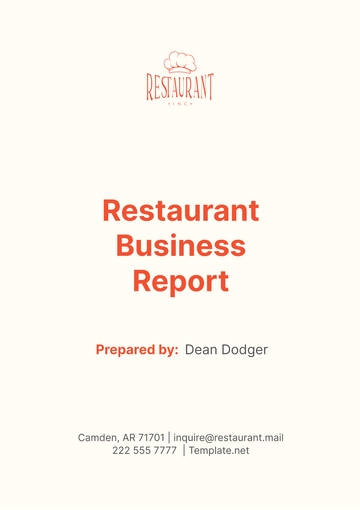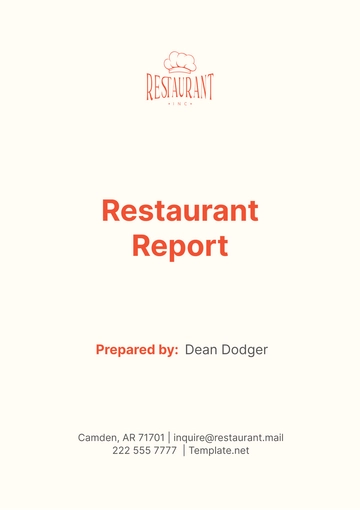Free Restaurant Food Waste Report

I. Executive Summary
This Restaurant Food Waste Report aims to evaluate our current food waste management practices, identify areas of significant waste, and provide actionable recommendations to reduce food waste. By addressing food waste, we seek to enhance our operational efficiency, reduce costs, and minimize our environmental footprint.
Key Findings
Total Food Waste: 500 pounds per week
Main Areas of Waste:
Kitchen preparation: 40%
Storage: 25%
Customer plates: 35%
Financial Impact: $2,000 per month in lost revenue
Environmental Impact: Equivalent to 1.5 tons of CO2 emissions per month
Root Causes:
Overproduction
Inadequate inventory management
Large portion sizes
II. Introduction
Our restaurant has been serving the community for over five years, offering a unique dining experience with our fusion cuisine. As part of our commitment to sustainability and operational excellence, we have undertaken a comprehensive food waste audit. The primary objectives of this report are to identify the sources and causes of food waste within our operations, assess the financial and environmental impacts, and recommend strategies to minimize waste.
III. Current Food Waste Practices
A. Current Practices
Currently, our food waste management practices include basic measures such as composting vegetable scraps and donating excess food to local shelters when possible. However, these efforts are not systematically implemented across all areas of our operations. We lack a comprehensive food waste reduction strategy that addresses all stages of the food preparation and consumption process.
B. Area Identification
We have identified several key areas where food waste occurs within our restaurant:
Kitchen preparation
Storage
Customer plates
Buffet line (during special events)
Ordering and inventory management
C. Audit Findings
Our recent food waste audit provided detailed insights into the quantity of waste generated in each area. The findings are summarized in the table below.
Area | Quantity (pounds per week) |
|---|---|
Kitchen preparation | 200 |
Storage | 125 |
Customer plates | 175 |
Buffet line | 50 |
Inventory management | 50 |
The audit revealed that kitchen preparation is the largest source of food waste, accounting for 40% of the total waste. This is followed by customer plates, which contribute 35% of the waste. The high levels of waste in these areas indicate inefficiencies in our food preparation processes and portion control practices. Additionally, significant waste occurs in storage due to improper inventory management, leading to spoilage and expired products. Addressing these areas will be crucial for reducing our overall food waste.
IV. Food Waste Data Collection
To accurately assess our food waste, we conducted a comprehensive data collection process. The methodology involved daily tracking of food waste across different areas of our operations over a three-month period. We collected both quantitative and qualitative data, including the weight and volume of wasted food, as well as the reasons for waste and common types of wasted food. This approach provided a holistic view of our food waste patterns and allowed us to identify specific areas for improvement.
V. Analysis of Food Waste Data
A. Quantitative Analysis
We analyzed the quantitative data to understand the scale and distribution of food waste in our restaurant. The table below summarizes the weekly average food waste values for each area.
Area | Quantity | Percentage |
|---|---|---|
Kitchen preparation | 200 | 40% |
Storage | 125 | 25% |
Customer plates | 175 | 35% |
Buffet line | 50 | 10% |
Inventory management | 50 | 10% |
The quantitative analysis reveals that kitchen preparation and customer plates are the largest contributors to food waste. These two areas alone account for 75% of the total food waste, indicating significant opportunities for improvement in food preparation and portion control.
B. Qualitative Analysis
We also collected qualitative data to understand the reasons behind food waste and identify common types of wasted food. The table below presents the key findings from this analysis.
Reason for Waste | Percentage of Occurrences |
|---|---|
Overproduction | 35% |
Spoilage | 25% |
Customer leftovers | 30% |
Expired inventory | 10% |
Type of Wasted Food | Percentage of Total Waste |
|---|---|
Vegetables | 30% |
Meat | 25% |
Dairy | 20% |
Bread and pastries | 15% |
Other | 10% |
The qualitative analysis indicates that overproduction and customer leftovers are the primary reasons for food waste. Vegetables and meat are the most commonly wasted food types, suggesting that better inventory and portion control could significantly reduce waste.
C. Seasonal Variations and Trends
Our data collection also considered seasonal variations and trends in food waste. The table below highlights the average weekly food waste values for different seasons.
Season | Quantity (pounds per week) |
|---|---|
Spring | 450 |
Summer | 500 |
Fall | 400 |
Winter | 450 |
The analysis shows that food waste peaks during the summer months, which could be attributed to increased customer traffic and seasonal menu changes. Understanding these trends can help us implement targeted strategies during peak periods to minimize waste.
VI. Impact of Food Waste
A. Financial Impact
Food waste has a significant financial impact on our operations. The table below outlines the cost of wasted food and potential savings from reducing waste.
Area | Cost of Wasted Food | Potential Savings |
|---|---|---|
Kitchen preparation | $1,000 | $500 |
Storage | $500 | $250 |
Customer plates | $700 | $350 |
Buffet line | $200 | $100 |
Inventory management | $200 | $100 |
The financial analysis indicates that reducing food waste could save us up to $1,300 per month. These savings could be reinvested into other areas of our operations to improve efficiency and customer satisfaction.
B. Environmental Impact
The environmental impact of food waste is significant, contributing to greenhouse gas emissions and landfill usage. Our current food waste levels result in approximately 1.5 tons of CO2 emissions per month. Additionally, a large portion of this waste ends up in landfills, exacerbating environmental degradation. By reducing food waste, we can lower our carbon footprint and contribute to environmental sustainability.
C. Social Impact
Food waste also has social implications, including ethical considerations and community impacts. Wasting food is an ethical issue, particularly when considering food insecurity in our community. By reducing food waste, we can potentially redirect excess food to local shelters and food banks, thereby supporting those in need and strengthening our community ties.
Addressing food waste not only improves our operational efficiency but also has positive financial, environmental, and social impacts. By implementing the recommended strategies, we can create a more sustainable and responsible dining experience for our customers and community.
VII. Root Causes
A. Operational Factors
Operational inefficiencies, such as overproduction and poor inventory management, have significantly contributed to our food waste. Our kitchen staff often prepares more food than necessary to avoid running out during peak hours, leading to excess waste. Additionally, inadequate storage practices have resulted in spoilage and expired products, further increasing waste levels.
B. Staff-Related Factors
Staff-related factors, including lack of training and awareness, have also played a role in our food waste problem. Many employees are not fully aware of the impact of food waste or the best practices to minimize it. Inconsistent portion control and handling practices among staff members have led to higher levels of waste from customer plates and kitchen preparation.
C. Customer-Related Factors
Customer preferences and behaviors significantly influence our food waste. Large portion sizes often result in uneaten food, contributing to waste from customer plates. Additionally, some customers may order more food than they can consume, leading to increased leftovers. Understanding and addressing these customer-related factors is crucial for reducing waste.
D. Supply Chain Factors
Supply chain inefficiencies, such as inaccurate ordering and inconsistent delivery schedules, have affected our ability to manage inventory effectively. Over-ordering and receiving products that are close to their expiration date have led to increased spoilage and waste. Improving our supply chain processes will be essential for minimizing food waste.
VIII. Best Practices and Benchmarking
To effectively reduce food waste, we can adopt industry best practices and benchmark our performance against similar establishments. The following are five best practices:
Implementing a Food Waste Tracking System: Regularly monitor and record food waste to identify patterns and areas for improvement.
Optimizing Inventory Management: Use a first-in, first-out (FIFO) system and conduct regular inventory audits to minimize spoilage.
Portion Control Training: Train staff to serve consistent portion sizes to reduce waste from customer plates.
Customer Education Campaigns: Inform customers about portion sizes and offer options for smaller portions to reduce leftovers.
Partnerships with Local Organizations: Collaborate with food banks and composting facilities to repurpose excess food and reduce landfill waste.
IX. Recommendations
To address the root causes of food waste and implement best practices, we recommend the following strategies:
Enhance Operational Efficiency: Implement a food waste tracking system and optimize inventory management.
Staff Training and Awareness: Conduct regular training sessions on portion control and food waste reduction.
Customer Engagement: Launch campaigns to educate customers on portion sizes and encourage responsible ordering.
Improve Supply Chain Processes: Work with suppliers to ensure accurate ordering and timely deliveries.
Strengthen Community Partnerships: Partner with local organizations to donate excess food and reduce waste.
X. Implementation Plan
The implementation plan outlines the steps needed to execute the recommended strategies, along with timelines and responsibilities.
Step | Timeline | Responsibility |
|---|---|---|
Implement food waste tracking | Operations Manager | |
Optimize inventory management | Inventory Manager | |
Conduct staff training sessions | HR Manager | |
Launch customer engagement campaign | Marketing Manager | |
Improve supply chain processes | Procurement Manager | |
Establish community partnerships | Community Relations Manager |
XI. Monitoring and Evaluation
Effective monitoring and evaluation are crucial for ensuring the success of our food waste reduction initiatives. The table below outlines the metrics and target values to track progress.
Metric | Target Value |
|---|---|
Total food waste (pounds) | 50% reduction |
Cost of wasted food (monthly) | $1,000 reduction |
CO2 emissions (tons) | 0.75 reduction |
Employee training completion | 100% |
Customer awareness score | 80% |
We will evaluate our progress on a quarterly basis, using the metrics outlined above. Regular reviews will involve analyzing food waste data, conducting staff feedback sessions, and gathering customer input. Adjustments to the implementation plan will be made as necessary based on the evaluation outcomes.
XII. Conclusion
Reducing food waste is essential for our financial health, environmental responsibility, and community engagement. By implementing the recommended strategies and continuously monitoring our progress, we can achieve significant reductions in food waste and create a more sustainable and efficient operation. Let's take decisive action to address food waste and contribute to a better future for our restaurant and community.
- 100% Customizable, free editor
- Access 1 Million+ Templates, photo’s & graphics
- Download or share as a template
- Click and replace photos, graphics, text, backgrounds
- Resize, crop, AI write & more
- Access advanced editor
The editable and customizable Restaurant Food Waste Report Template from Template.net enables you to monitor and reduce food waste in your establishment. Analyze data, identify root causes, and implement waste reduction strategies. Editable in our AI Editor tool, this template helps you create a comprehensive report tailored to your restaurant's unique needs and sustainability goals.
You may also like
- Sales Report
- Daily Report
- Project Report
- Business Report
- Weekly Report
- Incident Report
- Annual Report
- Report Layout
- Report Design
- Progress Report
- Marketing Report
- Company Report
- Monthly Report
- Audit Report
- Status Report
- School Report
- Reports Hr
- Management Report
- Project Status Report
- Handover Report
- Health And Safety Report
- Restaurant Report
- Construction Report
- Research Report
- Evaluation Report
- Investigation Report
- Employee Report
- Advertising Report
- Weekly Status Report
- Project Management Report
- Finance Report
- Service Report
- Technical Report
- Meeting Report
- Quarterly Report
- Inspection Report
- Medical Report
- Test Report
- Summary Report
- Inventory Report
- Valuation Report
- Operations Report
- Payroll Report
- Training Report
- Job Report
- Case Report
- Performance Report
- Board Report
- Internal Audit Report
- Student Report
- Monthly Management Report
- Small Business Report
- Accident Report
- Call Center Report
- Activity Report
- IT and Software Report
- Internship Report
- Visit Report
- Product Report
- Book Report
- Property Report
- Recruitment Report
- University Report
- Event Report
- SEO Report
- Conference Report
- Narrative Report
- Nursing Home Report
- Preschool Report
- Call Report
- Customer Report
- Employee Incident Report
- Accomplishment Report
- Social Media Report
- Work From Home Report
- Security Report
- Damage Report
- Quality Report
- Internal Report
- Nurse Report
- Real Estate Report
- Hotel Report
- Equipment Report
- Credit Report
- Field Report
- Non Profit Report
- Maintenance Report
- News Report
- Survey Report
- Executive Report
- Law Firm Report
- Advertising Agency Report
- Interior Design Report
- Travel Agency Report
- Stock Report
- Salon Report
- Bug Report
- Workplace Report
- Action Report
- Investor Report
- Cleaning Services Report
- Consulting Report
- Freelancer Report
- Site Visit Report
- Trip Report
- Classroom Observation Report
- Vehicle Report
- Final Report
- Software Report


